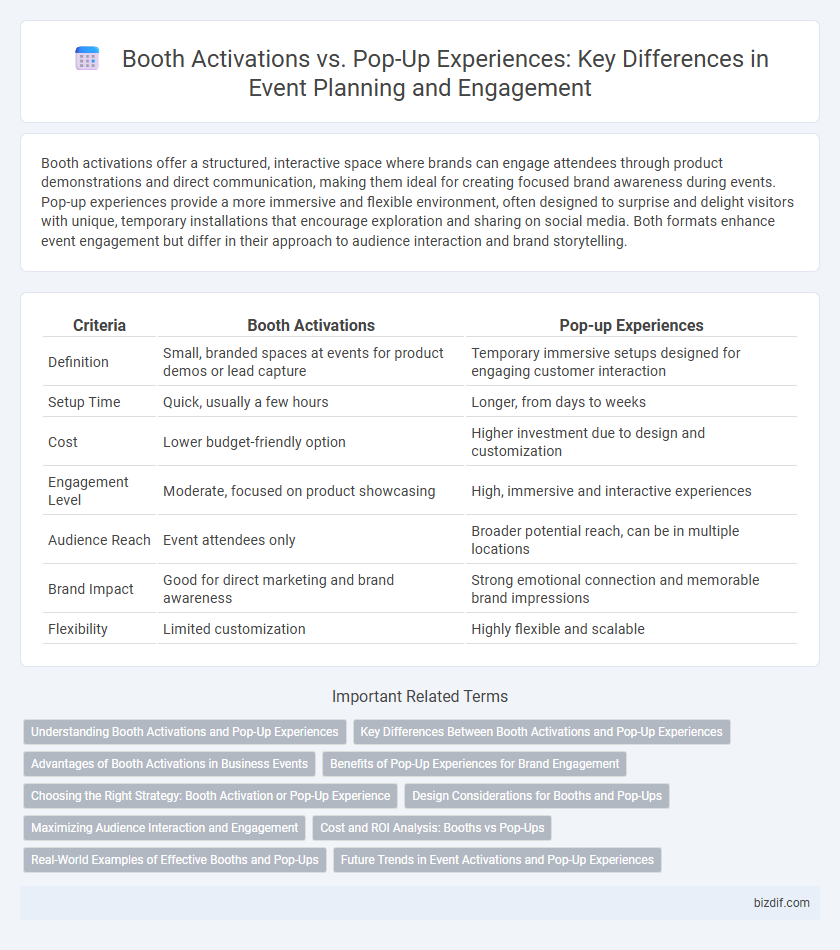Booth activations offer a structured, interactive space where brands can engage attendees through product demonstrations and direct communication, making them ideal for creating focused brand awareness during events. Pop-up experiences provide a more immersive and flexible environment, often designed to surprise and delight visitors with unique, temporary installations that encourage exploration and sharing on social media. Both formats enhance event engagement but differ in their approach to audience interaction and brand storytelling.
Table of Comparison
| Criteria | Booth Activations | Pop-up Experiences |
|---|---|---|
| Definition | Small, branded spaces at events for product demos or lead capture | Temporary immersive setups designed for engaging customer interaction |
| Setup Time | Quick, usually a few hours | Longer, from days to weeks |
| Cost | Lower budget-friendly option | Higher investment due to design and customization |
| Engagement Level | Moderate, focused on product showcasing | High, immersive and interactive experiences |
| Audience Reach | Event attendees only | Broader potential reach, can be in multiple locations |
| Brand Impact | Good for direct marketing and brand awareness | Strong emotional connection and memorable brand impressions |
| Flexibility | Limited customization | Highly flexible and scalable |
Understanding Booth Activations and Pop-Up Experiences
Booth activations are strategically designed setups at events where brands engage attendees through interactive displays, product demonstrations, and promotional giveaways to drive immediate interest and conversions. Pop-up experiences offer immersive, temporary environments that create memorable, branded interactions by transforming spaces into themed activations, often encouraging social sharing and extended engagement. Both approaches leverage experiential marketing techniques but differ in scale, duration, and the depth of audience interaction.
Key Differences Between Booth Activations and Pop-Up Experiences
Booth activations are typically stationary setups at events designed to engage attendees through branded displays and interactive elements, focusing on product demonstrations and lead generation. Pop-up experiences emphasize temporary, immersive environments that create memorable moments and often encourage social sharing to amplify brand reach. Key differences include duration, scale, and the level of sensory engagement, with pop-ups offering more dynamic, often larger-scale interactions compared to the fixed and focused nature of booth activations.
Advantages of Booth Activations in Business Events
Booth activations offer targeted brand visibility and direct audience engagement, making them highly effective for lead generation in business events. Their structured setup provides a consistent environment for product demonstrations, data collection, and real-time customer feedback. The physical presence of booth activations also fosters stronger networking opportunities and brand recall compared to temporary pop-up experiences.
Benefits of Pop-Up Experiences for Brand Engagement
Pop-up experiences offer immersive and interactive environments that foster direct consumer engagement, enhancing brand recall and emotional connection. These temporary setups generate a sense of exclusivity and urgency, driving foot traffic and social media sharing more effectively than traditional booth activations. Brands benefit from increased flexibility in location and design, allowing tailored experiences that resonate deeply with target audiences and boost overall brand awareness.
Choosing the Right Strategy: Booth Activation or Pop-Up Experience
Booth activations provide structured, interactive spaces designed to engage attendees with branded content and product demonstrations, ideal for trade shows and conferences seeking direct lead generation. Pop-up experiences offer immersive, temporary environments that create memorable emotional connections and social media buzz, perfect for brand awareness and consumer engagement in dynamic locations. Selecting between booth activations and pop-up experiences depends on marketing goals, target audience behavior, and desired level of interactivity.
Design Considerations for Booths and Pop-Ups
Booth activations require strategic spatial planning to optimize brand visibility and visitor flow within a confined area, emphasizing modular design elements and interactive displays for maximum engagement. Pop-up experiences prioritize immersive environments that leverage sensory design, flexibility in layout, and rapid assembly materials to create memorable, context-driven brand interactions. Both approaches demand careful attention to lighting, signage, and technology integration to enhance user experience and reinforce brand messaging effectively.
Maximizing Audience Interaction and Engagement
Booth activations create a structured space for brand messaging and direct product demonstrations, maximizing audience interaction through targeted displays and interactive technology. Pop-up experiences leverage immersive environments and limited-time exclusivity to drive spontaneous engagement and emotional connections with attendees. Both strategies enhance engagement by combining sensory stimulation with participatory elements, but pop-ups often generate higher social sharing and viral interest.
Cost and ROI Analysis: Booths vs Pop-Ups
Booth activations typically involve higher upfront costs due to custom design, construction, and staffing, but they offer prolonged brand visibility and lead generation opportunities, resulting in a potentially higher ROI over large-scale events. Pop-up experiences generally require lower investment with flexible, temporary setups that create urgency and exclusivity, which can drive quicker consumer engagement and immediate sales impact. When comparing cost and ROI, booth activations suit long-term brand awareness goals, while pop-ups excel in rapid market testing and conversion efficiency in localized environments.
Real-World Examples of Effective Booths and Pop-Ups
Booth activations by brands like Coca-Cola at major sports events create immersive, interactive experiences that drive direct consumer engagement and social media buzz. Pop-up experiences such as Glossier's temporary stores in urban centers generate exclusivity and brand excitement, leveraging limited-time events to boost sales and brand loyalty. Both approaches utilize strategic location and visually compelling design to maximize foot traffic and memorable participant interactions.
Future Trends in Event Activations and Pop-Up Experiences
Booth activations are evolving with immersive technologies such as augmented reality and interactive displays that enhance attendee engagement and data collection. Pop-up experiences increasingly emphasize personalized, multi-sensory environments that create memorable brand interactions and encourage social sharing through innovative design and digital integration. Future trends highlight seamless hybrid event models combining physical activations with virtual reality elements to expand reach and provide dynamic audience experiences.
Booth activations vs Pop-up experiences Infographic

 bizdif.com
bizdif.com